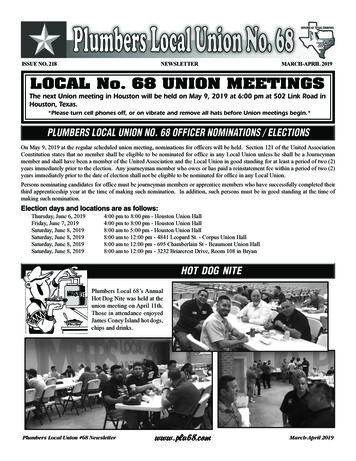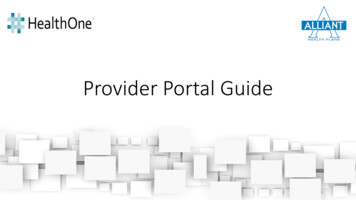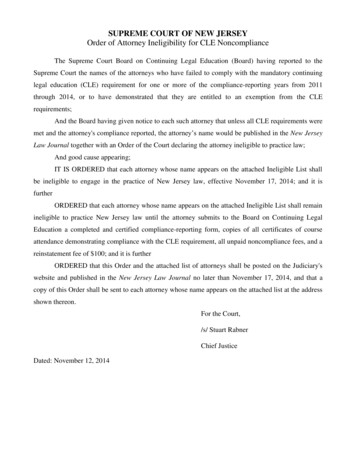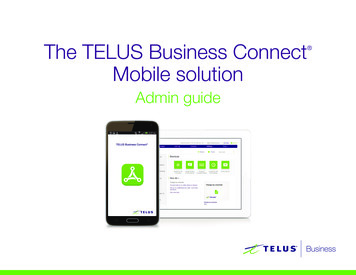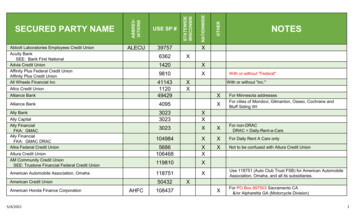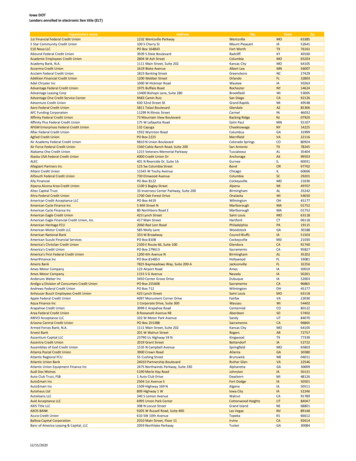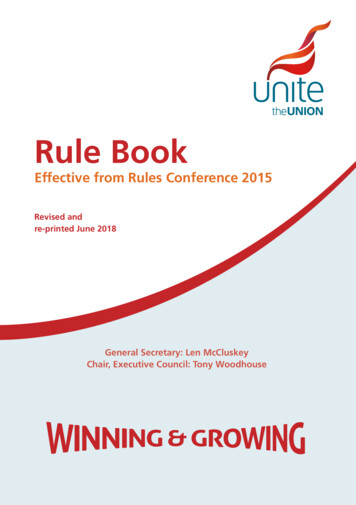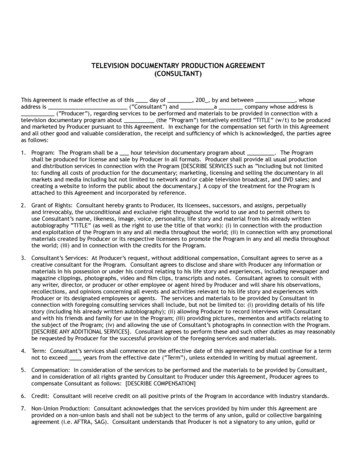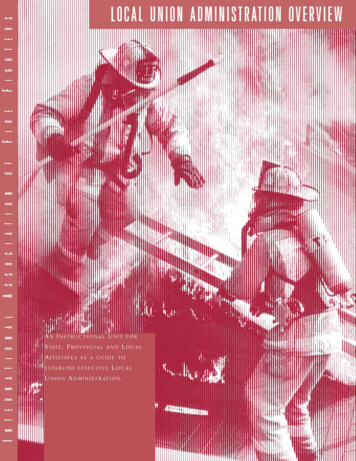
Transcription
L O CA L U N I O N A D M I N I S T R AT I O N OV E RV I E WOUTLINEIf your local union is to meet the needs of its membersit must be operated in an effective and efficientmanner. This not only includes the structure of yourlocal as determined by its constitution and by-laws,but the performance of its officers in accordance withthe provisions of these documents. Local UnionAdministration Overview will help you and yourlocal in achieving the goals your members have setfor it. You will find information on the duties of eachlocal union officer, as well as responsibilities of theexecutive board and other committees in your local.Discussion on how to conduct membership meetings,operate committees, develop PR programs, organizepolitical structures, manage union halls, and educateyour members is provided as well.OBJECTIVESThe objectives of this workshop are to:acquaint you with how the internal structure ofyour local should operate;familiarize you with how to encourage membership involvement through committees;assist you in your local’s public relations effortsboth internally and externally;familiarize you with how your local can becomemore politically active through legislativeinvolvement;assist you in educating your members on issuesimportant to your local union;familiarize you with how a union hall should bestructured and its uses as a business office and ameeting place; andacquaint you with the various services and assistance available from the IAFF.COMPETENCIESAt the conclusion of this session, you will havereceived training and information to assist you inaccomplishing each of the following competencies.You will:understand why your local union constitution andby-laws establish the basic organization of yourlocal;be able to identify the duties of a local union president, local union secretary, local union treasurer,and local union executive board;be familiar with the fiscal responsibilities of yourmembers and your local union;know why it is important for your local to affiliateitself with other labor organizations;know about your local’s bargaining agent responsibility and “duty of fair representation”;know how a membership meeting should beconducted;know the differences between standing committeesand special committees;be able to determine the size and make up of acommittee;be familiar with the rules, rights and responsibilities that govern the committees of your local;be able to effectively use public relations to motivate your members;know how to use public relations to help your localunion present a positive image to your communityand influence decisions that affect your members;be able to differentiate between federal and nonfederal elections so that your local can make contributions to campaigns appropriately;understand the importance of your union becoming involved in the political process at the local,state and federal levels;be able to identify grassroots lobbying as the mosteffective method of political involvement;3
know of the importance of educating your members about the policies and decisions of your localunion;be able to identify the three different types oftraining programs available from the IAFF;understand the importance of the identity of yourlocal through the establishment of its union hall;know that the business office of your local is anarea set aside for the purpose of conducting theadministrative function of your local;be able to identify the functions and uses of aunion hall;be able to identify the various services availablefrom the IAFF on politics, public relations, education, safety, negotiations, hazardous materials andEMS; andunderstand the importance of becoming involvedwith your state/provincial association.TEXTBOOKSANDREFERENCESLocal Secretary-Treasurer’s Informational Manual,developed by the International Association of FireFighters.Local Union Administration, developed by theInternational Association of Fire Fighters.An Overview of Membership Services, developedby the International Association of Fire Fighters.Political Action for Fire Fighters, developed bythe International Association of Fire Fighters.Public Relations—Putting it All Together, developed by the International Association of FireFighters.
S U B J E C T M AT T E RI.Internal Structure of a Local UnionA. Local Union Constitution and By-LawsB. General Operations1. Basic Organizational Structurea. Administrative Operationsb. Dues/Fiscal Responsibilitiesc. Organizational Affiliations2. Bargaining Agent Responsibility (Dutyof Fair Representation)C. Membership MeetingsII. CommitteesA. Standing CommitteesB. Special CommitteesC. Size and Make Up of CommitteesD. Goals, Charges and Authority ofCommitteesIII. Public Relations, Communications, andMembership MotivationA. InternalB. ExternalIV. Political Action and Legislative InvolvementA. Political Action Committees (PAC’s)1. Funds2. OrganizationB. Involvement in Local, State and FederalLegislation and CandidatesC. Methods and Types of Political Activitiesand InvolvementV.EducationA. InternalB. Training ProgramsVI. Office – Union HallA. Local IdentificationB. Business OfficeC. Function and Uses of a Union HallVII. Effective Use of the IAFF andState/Provincial AssociationsA. Services Available from the IAFFB. Services Available from State/ProvincialAssociations
L O CA L U N I O N A D M I N I S T R AT I O N OV E RV I E WINSTRUCTIONAL UNITI. INTERNAL STRUCTURE OFA LOCAL UNIONB. G E N E R A L O P E R AT I O N S1. Basic Organizational StructureInstructor Notes:Begin your presentation by introducing yourself and briefly stating the objectives of yourpresentation (use slide #1).A. LOCAL UNION CONSTITUTIONA N D B Y- L A W SInstructor Notes:Point out that a local union constitution andby-laws establishes the basic organization of alocal (use slide #2).Through its constitution and by-laws, your localestablishes its basic organization, including theduties and responsibilities of your local unionofficers, executive board and committees, as wellas the various procedures that govern differenttypes of meetings.Your local’s constitution and by-laws should provide the precepts necessary for governing yourmembers. It should meet their needs, as well asbe flexible for reasonable and future change.The more definitive responsibilities, objectivesand organizational goals of your local should beexpressed in the preamble of your constitutionand by-laws. It is the duty of all your members torespect these principles and carry them out whileperforming their duties as members of the fireservice.Your constitution and by-laws must mandate theauthority and responsibilities of all of its executiveofficers, including your president, secretary,treasurer, and members of your executive board.It must also establish how your local will carry outall of its business and conduct all of its meetings.a. Administrative OperationsInstructor Notes:Point out that the administrative operationsof a local are usually performed by a president,a secretary, a treasurer, and an executive board(use slide #3).Discuss the general duties of a local unionpresident (use slide #4).Discuss the general duties of a local unionsecretary (use slide #5).Discuss the general duties of a local uniontreasurer (use slide #6).Discuss the general duties of a local unionexecutive board (use slide #7).In most circumstances, local union officersconsist of a president, secretary, and treasurer.Between membership meetings, all administrative, executive and judicial powers of a localare performed by an executive board.The president of your local union serves asyour local’s executive head. The president’sgeneral duties include:Presiding over all meetings of your local, aswell as over all of its executive board meetings.Appointing all committees provided for inyour local’s constitution and by-laws.Signing all orders and checks that areproperly and lawfully drawn.Enforcing the observance of the International’s Constitution and By-Laws and theconstitution and by-laws of your local.Supervising the activities of other localunion officers and chairpersons of yourcommittees.Serving as delegate for your local at thebiennial IAFF Convention.7
The secretary of your local union acts as yourlocal’s primary communications specialist. Thesecretary’s general duties include:Keeping custody of general documents,records, books, and papers belonging to yourlocal, except as otherwise stated in your localconstitution and by-laws.Keeping an accurate record (meetingminutes) of your local union and executiveboard meetings.Attesting all official documents with thesecretary’s signature and seal of your local.Conducting general correspondence of yourlocal.Maintaining and securing accurate andcurrent lists of members in good standing.Executing and maintaining records ofreports that are filed with federal and stateauthorities.The treasurer of your local union keeps anappropriate record of all financial transactionsof your local. The treasurer’s general dutiesinclude:Receiving all money due your local andinsuring that all funds are deposited in yourlocal’s proper account on a frequent basis.Disbursing all money owed by your localin an approved manner.Maintaining a current record of memberswith their dues payments, assessments, and allfinancial transactions.Exhibiting receipts and vouchers uponaudit of your books.Forwarding your local’s annual audit to theInternational Secretary-Treasurer.Your local union executive board is the governing body of your local when called into session by your local union president. Your executive board is a standing committee and thismeans it must have a chairperson, as well as asecretary. In most cases the local union president and the local union secretary performthese duties.b. Dues/Fiscal ResponsibilitiesInstructor Notes:Discuss the fiscal responsibilities of eachIAFF member and local affiliate (use slide #8).The International Constitution and By-Lawsrequires that all its members pay dues on amonthly basis. If a member fails to make hisdues payment by the fifteenth day followingthe month that the dues are payable, then it isthe duty of your local to notify the memberthat he1 is delinquent and that he will be automatically suspended if payment is not madewithin sixty days following the notification.You are also responsible for making a monthlyreport to the International of any members whoare delinquent in their dues.Each member of the International is also issueda membership number that appears on hismembership card. This number is used foridentification purposes and prevents mistakeswhen there are several members with the samefirst and last names.It is the duty of your local to be sure that membership numbers are included in the per capitatax reports. The per capita tax report is theonly way that the IAFF has of knowing whothe members of your local are. This report isthe basis for issuing membership cards as wellas constituting the source of representation ofyour local at the biennial IAFF Conventions. Italso provides the information necessary for themailing of the IAFF magazine, InternationalFire Fighter.Accuracy is essential in making out the percapita tax report. This includes the spelling ofmembers’ names, addresses, and zip codes. Itis also important to be accurate in reportingnew members, members’ address changes,retired members, active retired members, members on military leave, and deceased members.1. Whenever a male gender is used in this document, it shall be construed to include both women and men.8
c. Organizational AffiliationsInstructor Notes:Discuss the importance of a local unionaffiliating itself with other labor organizations(use slide #9).It is wise for your local union to affiliate itselfwith other labor organizations. The most common affiliations would be with other AFL-CIObodies such as your area’s central labor council,your state labor body, and the IAFF state/provincial association having jurisdiction overyour local union.By maintaining an active role with other labororganizations, your local’s sphere of influencecan be greatly broadened in terms of publicrelations, political activities, and how organizedlabor represents the interests of your members.As an affiliate of an AFL-CIO labor body, yourlocal’s issues—political and otherwise—becomethe issues of a much broader group that alreadyhas an established support network.In addition, your local should consider usingthe wide range of services that your IAFFstate/provincial association offers. It is important that your local union inquire and then usethese services to help meet the needs of yourmembership.2. Bargaining Agent Responsibility(Duty of Fair Representation)Instructor Notes:Discuss a local’s bargaining agent responsibility and the items that each local union shouldbe familiar with when representing their members at the bargaining table (use slide #10).Define “duty of fair representation” anddiscuss the importance of representing allmembers of a local indiscriminately and fairly(use slide #11).Most local unions are responsible for securingbetter wages and working conditions on behalfof their membership. This is true in both anunstructured and structured bargaining environment. Therefore, because of your local’sbargaining agent responsibility, the fundamentals of bargaining a collective agreementshould always be applied when appropriate.This means that your local union should familiarize all the direct participants in this processwith each of the following:an understanding of your exact bargainingenvironment;the purpose of collective bargaining and itsprocess;a knowledge of the different techniquesused to facilitate the process;how to prepare contract proposals andcounterproposals;how to use the strategy of “pressure”; andan understanding of the processes at thebargaining table, including preparation, groundrules, presentation of proposals, actual negotiation, caucusing, and tentative agreements(subject to the entire agreement) which in turnare presented for membership consideration(ratification).Your local union is also responsible for theprotection of the rights of all of its members.Under the National Labor Relations Act yourlocal is legally obligated to represent all of itsmembers indiscriminately and fairly.2 Thismeans that all members of your local are entitled to the same treatment and cannot betreated differently because of internal politicalconsiderations. It also means that your localcannot charge a fee to a non-union member ifthe other bargaining unit members are notsubject to the same charge.Obviously it is to the advantage of your localto avoid any possibility of being sued forbreach of “duty of fair representation.” Courtcosts are substantial even if your local wins.Therefore, all officers of your local shouldknow what standards exist for fair representation and the duty it imposes. Your local shouldalso make certain all of its newly elected orappointed officials receive thorough trainingand instruction in “duty of fair representation.”2. Some IAFF locals that represent state and municipal government workers are not subject to the National Labor Relations Act. Theselocals should consult their state statutes or PERB decisions for any requirements concerning “duty of fair representation.” Federallocals are required under section 7114(a)(1) of Title 5, United States Code, to represent all their members without discrimination.9
C. M E M B E R S H I P M E E T I N G SInstructor Notes:List the items that should be considered whenconducting a membership meeting (use slide #12).Discuss the responsibilities of a presidingofficer at a membership meeting (use slide #13).In most circumstances, you will find that attendance at your membership meetings is highestwhen elections are being held or when your contract is up for ratification. Since it is impossibleto have an election or contract ratification forevery meeting, it is important to plan an agendathat will attract the interests of your members.Your membership meetings should have a purpose and require some sort of action from yourmembership. Ideally, issues should be discussedthat your members need to decide on.Once a decision has been made on the topics tobe presented, an agenda will need to be preparedand circulated among your membership. Thisagenda should serve as a notice and state the purpose of the meeting. It should be distributed threeto five days in advance so your members willhave a chance to consider the topics and makelogistical arrangements.When conducting the meeting, several itemsshould be considered. These include:Starting the meeting on time. Punctuality letsyour membership know that the agenda will befollowed and that their time is respected.Introducing the officers. Even if there areonly one or two new people at the meeting, introductions of the officers and others is appropriate.Using the parliamentary procedure adoptedby your local union. The IAFF suggests using“Atwoods Rules for Meetings.”As an elected officer of your local, your president will serve as the presiding officer at yourmembership meetings. Running the actual meeting requires the presiding officer to accomplishseveral different tasks simultaneously, includingthe following items.10Maintaining Order—Your members mayaddress the meeting only after the presiding officer has given them the floor. Never forget thatthe presiding officer decides WHEN a memberwill speak, not WHETHER a member will speak.Debates—The presiding officer must neverallow debating to result in personal abuse or thequestioning of members’ motives. It is hisresponsibility to see that a debate is orderly andon the issue.Setting an Example—The presiding officermust always set an example for all your membersby obeying the International’s Constitution andBy-Laws and he must refuse any motions madecontrary to any provision of this document.Voting—As a member of your local, thepresiding officer has the right to vote. However,no member, including the president, can beforced to vote.II. COMMITTEESInstructor Notes:Point out that a local union functions throughits standing and specially designated committees(use slide #14).Your local union as an organization functionsthrough its standing and specially designatedcommittees. Under the direction of your localunion president, these committees perform theinvestigative and research work on motions andpolicies prior to a vote by your membership.A . S TA N D I N G C O M M I T T E E SInstructor Notes:Define standing committees (use slide #15).Standing committees can either be elected by yourmembership or appointed by your president to servefor a definite term as described by your local’sconstitution and by-laws. The foremost standingcommittee in your local is your executive board.The authority of your executive board is set forth inyour local’s by-laws and its quorum is establishedwith your president as chairperson of the board.
B. S P E C I A L C O M M I T T E E SInstructor Notes:Define special committees (use slide #16).Special committees are also elected or appointedas required by your local’s by-laws. They areestablished to accomplish a specific task thendissolved when their final reports are submitted(unless discharge requires a membership vote.) Aspecial committee is created by a motion thatshould include the selection process of its members, the number of members and the date itsfinal report is to be given. Your local union president oversees the work of each special committeeand provides specific directions to each chairperson. It is the responsibility of the local unionsecretary to transfer all necessary materials toeach special committee chairperson. Upon receiptof these materials, the special committee chairperson is responsible for these materials until thefinal report is submitted, with all materials thentransferred back to the local union secretary.C. S I Z E A N D M A K E U PCOMMITTEESOFInstructor Notes:Point out that a committee can consist of oneor more members, but that it is best if a committee is held to a small number.A committee can consist of one or more members.However, care should be taken that the committee is held to a small number. Committees foraction usually consist of one to three members,while committees whose objective is to deliberateusually consist of five or more members.D. G O A L S , C H A R G E S A N DAUTHORITY OF COMMITTEESInstructor Notes:Discuss the general rules, rights and responsibilities that govern the committees of a local(use slide #17).Committee meetings are much more informalthan your local union meetings. Committeemembers have the right to speak as many timesas they want on a subject and if he chooses, thecommittee chairperson can make motions whilepresiding. Also, many motions made during acommittee meeting do not require a second.Unless they are committee members, members of your local do not have the right to attenda committee meeting. The only exception to thismandate is if the member is invited to addressthe group and then is excused for the committee’s discussions and voting activities.Committee meeting minutes are only readbefore the committee and never before the localunion membership. Members of a committeeshould also refrain from discussing the proceedings and actions taken by their committee withother members of your local until the final reportof the committee is delivered.A committee has the option of creating a subcommittee. A subcommittee consists of membersof the committee appointed by the chairperson.The chairperson’s responsibilities to his subcommittees are the same as that of a local unionpresident and secretary to their committees inthat the chairperson must provide specific directions and delivery of necessary materials for theassignment.In the event a committee does not functionand fails to submit a report, your local unionmembership has the authority to dissolve thecommittee by a motion and a vote. A vote to dissolve a committee requires a two-thirds voteunless your membership has received an advancenotice concerning the committee’s discharge. In acase such as this, a majority vote is required todissolve the committee.Some general rules, rights and responsibilitiesthat govern the committees of your local includethe following items:11
I I I . P U B L I C R E L AT I O N S,C O M M U N I CAT I O N S, A N DMEMBERSHIPM OT I VAT I O NA. INTERNALInstructor Notes:Give examples of how to motivate membersthrough the internal use of public relations (useslide #18).One of the best ways for a union member to keepinformed and motivated is by attending unionmeetings. However, due to a variety of reasons,there are a number of members who do notattend all meetings, and as such are not asinformed and motivated as you might want themto be. One of the best ways to overcome thisproblem is with the publication of a localnewsletter. A newsletter gives your local theopportunity to maintain contact with all of itsmembers concerning important issues. A newsletter will also help to establish an openness andcredibility for your organization as well.While a newsletter is probably the most effectiveway to foster good member relations and motivation, it does not have to be the only way. Thereare an assortment of other items that can helppromote your union’s image of brotherhood andsisterhood among your membership, while at thesame time be of public relations value. For example, you can issue memos, use bulletin boards,and allow members to access information viatheir computers.You should also use your steward as much aspossible. Every steward has a special relationshipwith the fire fighters he represents. In some ofthe larger local unions the average fire fightermay not even know his own union president. Notonly is the steward a key person in your local,but in some instances he is the first-line of leadership for the majority of your local’s members.His ability to transmit information and motivateyour membership should not be overlooked.B. E X T E R NA LInstructor Notes:Discuss some of the various methods of conducting an effective and on-going PR campaign(use slide #19).Public relations is an important key to the success and future of your local union. A wellmanaged PR operation can help your local unionpresent a positive image to your community andinfluence decisions that affect your members asprofessional fire fighters and emergency medicaltechnicians. By conducting an effective and ongoing PR campaign, your local can have directaccess to the public and better present your sideof the story on important issues.Everyday and in everything you do, your localshould be reaching out to politicians, businessleaders, community groups, and the general public. One such way of accomplishing this objective is through community relations. Generally,community relations activities include projectsthat might not be a direct benefit to your members, but will benefit the community in whichthey live and work. These types of activities helpthe community remember that your members arededicated public servants. Some examples ofcommunity relations activities your local maywant to consider include: assisting boy scouttroops, sponsoring little league teams, setting upblood donor visits for the Red Cross, performingCPR demonstrations, operating blood pressurescreenings, or conducting fire/burn preventiondemonstrations for homeowner and businessassociations.Another important aspect of your PR operation ispublic education. Due to the drama of fire fighting your career is a highly salable item to thepublic. However, many people do not fullyunderstand all of the techniques, procedures,operations and problems associated with firefighting. It is up to your local to communicateand inform your citizens to help alleviate theseinaccuracies.13
Your union’s relationship with your employer isalso vital to the success of your local. The overallpublic opinion regarding your fire department isformulated largely on the quality and quantity ofthe services it provides. However, in terms ofpublic relations, the manner in which theseservices are performed is often more importantthan the actual service itself. In order to establishgood relations with your employer and thepublic, your members must not only be effectivein performing their duties in a technical and professional manner, but must also perform theirduties in a manner that earns citizen approval andconfidence.I V.POLITICAL ACTIONL E G I S L AT I V EI N V O LV E M E N Tvidual voluntary contributions. Federal candidates are not allowed to accept money fromcorporations or labor union treasury fundaccounts. These restrictions are detailed in theFederal Election Campaign Act (FECA) of1975 and subject to regulations by the FederalElection Commission (FEC).State and local campaign laws have the samegeneral purpose as the federal law (FECA) andapply to non-federal elections, such as statejudicial offices, state legislature andcity/county offices. These laws vary from stateto state and are subject to frequent change.2. OrganizationANDInstructor Notes:Point out that the worst time to organize apolitical structure in a local is in a time of crisis(use slide #20).The key to political success is being organized.If you don’t already have a political operation inplace in your local—develop one. The worst timeto begin organizing a political structure in yourlocal is in a time of crisis.A. POLITICAL ACTIONC O M M I T T E E S ( PA C ’ S )Instructor Notes:Discuss how the funds and organizations ofPAC’s are different on the federal, state/provincial,and local levels (use slide #21).1. FundsThere are two types of elections: federal andnon-federal (state and local). Before makingany contributions to a candidate or politicalparty, it is first necessary to determine the typeof election. Federal elections include presidential, U.S. Senate and U.S. House races.Candidates seeking these offices are allowed toaccept money only from individual contributors and federal PAC’s, such as the IAFF’sFIREPAC. These funds are raised from indi-14For your local to remain politically active atthe state and local level, you should considercreating a non-federal PAC to assist in yourefforts. In establishing a non-federal PAC, youwill have to refer to your state’s campaignfinance laws. You can do this by contactingyour state’s agency responsible for governingnon-federal PAC’s.B . I N V O LV E M E N T I N L O C A L ,S TAT E A N D F E D E R A LL E G I S L AT I O N A N D CA N D I DAT E SInstructor Notes:Discuss the reasons for becoming involvedin politics at the local, state and federal levels(use slide #22).Your local has a right and obligation to speak outand participate in the political process whenissues affecting your members are raised by candidates seeking office. Your local also has a rightand obligation to seek out the support of candidates on those issues that affect your membersand their livelihood. Political involvement isimportant and your local must take an active partin the political process at all levels to protectyour member’s jobs, pensions, health, and safety.If not, your local will witness an erosion of itsinfluence in your community.Even though national legislation helps fire fighters,your members are, and will be more directly
affected by legislation adopted at the state/provincial and local levels. When focusing onpolitical activities, keep in mind that politics is a“two-way street”. Your local cannot only beinterested in, and work for legislation that onlyaffects your members. It must be attuned to theproblems and needs of your community as awhole and work towards meeting and correctingthem as well.state/provincial, and local levels who havedemonstrated concern for the good and welfareof your community and membership;involvement in voter registration drives witha special emphasis on your own membership;andraising funds because without adequatefinancing it is unlikely that any of the aboveactivities could be successfully carried out.Always remember that your rig
It is wise for your local union to affiliate itself with other labor organizations. The most com-mon affiliations would be with other AFL-CIO bodies such as your area's central labor council, your state labor body, and the IAFF state/ provincial association having jurisdiction over your local union. By maintaining an active role with other labor
